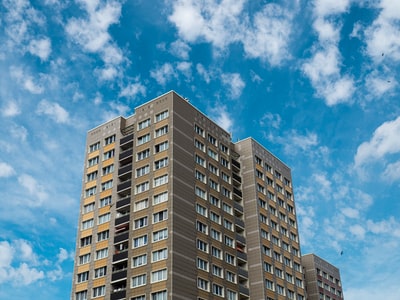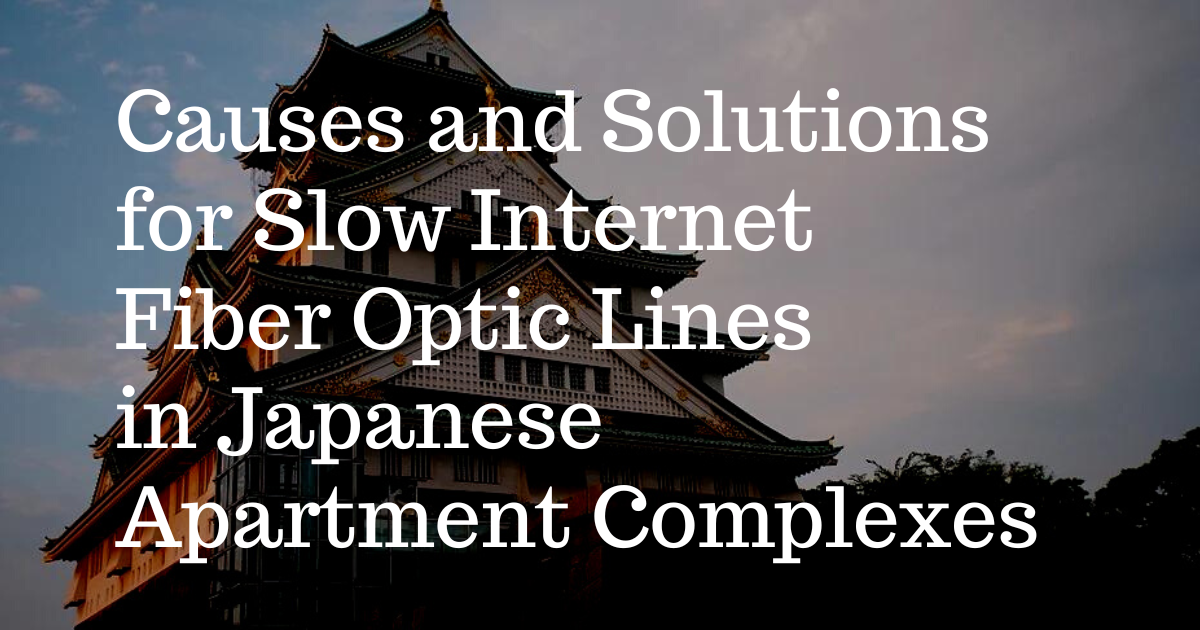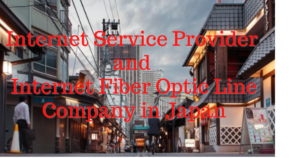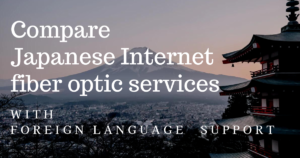If you live in a condo or apartment in Japan.
I would like to warn you about fiber optic lines.
When you sign up for a fiber optic line in a Japanese housing complex, the speed of the fiber optic line is very slow in some cases.
This is due to the unique method of fiber-optic lines in Japanese apartment complexes.
I write on this page the causes of slow optical line speeds in Japanese housing complexes and how to improve them.
Does this page have the information you want to know?
This site contains information on .fiber optics line, home routers, mobile wifi, sim cards, and free wifi.
Please click on each word to go to the summary page.
Is the fiber optic line speed slow in apartments and condominiums in Japan?

Internet speeds in apartment complexes tend to be slower than in houses in Japan.
This page describes the causes of slower fiber optic lines in apartment complexes.
You should know the cause of it.
I want you to get a fast and comfortable internet fiber optic line.
Causes of Slow Internet Fiber Optic Lines in Japanese Housing Complexes
Cause 1: Wiring in the building is not fiber optic.
Fiber optic lines in a single house in Japan are pulled into the house from utility poles.
Fiber optic lines for apartment complexes in Japan are pulled from utility poles to the common areas of the complexes via optical fiber and connected to a branching device.
This fiber optic line is then branched from the common area to each room, either by optical fiber, LAN cable, or VDSL (telephone line).
If the wiring to each room is fiber optic line, high-speed Internet access is available.
If the wiring from the common area is VDSL system (telephone line) or LAN cable, the Internet will be very slow.
Theoretically, the maximum speed of fiber-optic cable is 1 Gbps.
And the VDSL and LAN cable system has a theoretical maximum of 100 Mbps.
This is a big difference.
Cause 2: Many users of fiber optic lines at the same time of day in a housing complex
The more households there are in a housing complex (condominiums and apartments), the more optical fiber lines are shared among them and the more congested they become.
This fiber optic line congestion reduces communication speed.
Fiber optic lines are usually used by splitting them into 32 branches.
This is the same for both single-family homes and apartment complexes.
However, there may not be many people around a single-family home who subscribe to the same fiber optic line.
When 8 households subscribe to a 1Gbps optical line, the speed of a 1Gbps optical line is 1000÷8=125Mbps (when 8 households use the line at the same time).
And, in a housing complex, each apartment or condominium has a contract with one line company.
And in many cases, all of these 32 branches of the line are used.
The speed of a 1Gbps optical line is 1000÷32=31.25Mbps (when 32 households use the line at the same time).
When there are many residents home at night and on holidays, more people use the Internet in an apartment complex.
Internet becomes congested and slow.
Cause 3: There is a problem with the Internet service provider.
It could be caused by the Internet provider that your apartment complex has a contract with.
This is poor performance of the provider’s equipment.
The provider has a contract with more users than it can handle.
The provider is not adapted to the latest IPV6 (IPOE) and the provider is using the older IPV4 (PPPOE).
Consult with the provider and switch to IPV6 (IPOE) .
Or change to a different provider.
There are several ways to improve your Internet speed.
Cause 4: Your Internet equipment is old
When the Wi-Fi router or ONU (Optical Network Unit) you are using at home is old, the Internet connection speed may be slow.
In this case, the cause of the slow fiber optic line is not the apartment complex.
Check your router or ONU equipment.
If your device is old wireless LAN standard, its speed may be slow.
Internet fiber optic line standards are explained in the page below.
If your router or ONU is the cause of the slow line speed,
I recommend that you change to the latest standard equipment.

Cause 5: Something is affecting the wireless wifi.
Wireless WIFI causes internet connection failure due to some effect.
Microwave ovens and other devices interfere with wireless WIFI.
Wifi wireless has 2.4GHz and 5GHz radio waves.
The 2.4GHz radio waves is close to the frequency emitted by microwave ovens and other household appliances.
For example, you use a microwave oven in your room, or your neighbor uses a microwave oven.
The electromagnetic waves from this device will affect your wireless WIFI.
And the communication speed will be slowed down, causing poor connection.
In this case, using 5GHz radio waves will solve the problem.
However, your router may not support 5GHz communication.
Check the manual of your WIFI router to confirm this.
The aquarium absorbs wireless Wifi signals.
The 5 GHz band has the advantage of being free from radio interference from consumer electronics.
However, 5GHz radio waves are vulnerable to water and obstacles, and the radio waves may be absorbed.
You will make an improvement if you avoid placing water tanks or obstacles around the wireless wifi router.
The channels used by the neighbors overlap with your wireless wifi.
Wireless Wifi has a channel. Usually, this channel has 1 to 14 channels.
When these channels overlap between neighbors, the wireless wifi causes radio interference.
The wireless wifi will then experience a decrease in transmission speed.
You can check the channels with an app on your smartphone.
It is a good idea to use a channel that does not overlap with the signal of neighboring residents.
Solutions to Slow Internet in Japanese Housing Complexes
I wrote 5 causes of slow down of optical line in apartment complexes above.
Causes 4 and 5 can be remedied by you.
However, causes 1-3 are related to the building equipment and surrounding residents.
It is difficult to improve these causes.
Here I write some improvement methods.
Solution1:Changing from VDSL or LAN cable to fiber optic in an apartment complex
If you want to convert the wiring in your apartment complex to fiber optic, there are two tasks you must perform.
The most important task is to get the landlord and management company to permit the installation.
And the second most important task is to get the fiber optic line company to permit the installation.
The fiber optics company will consider whether the fiber optics contractor can install fiber optic fiber to all the households in the apartment complex.
If the fiber optic line company can install in all households, the fiber optic line company will permit the installation.
Older condominiums often have clogged pipes or no pipes to run optical fiber. Therefore, the optical fiber contractor must install new piping.
In this case, the construction work is more extensive. And often the building management will not allow it.
Few optical fiber suppliers change from VDSL and LAN cables to fiber optics.
When asking for a fiber optic supplier who can handle the project, you need to get more than a certain number of subscribers in the same building.
Solution2:Only one household signs up for a fiber optic line for a single family plan.
It is difficult to convert all VDSL to fiber optic in all housing complexes.
In such a case, I recommend you to sign up for a single-family optical line plan independently.
If you sign up for a single-family plan, you will need to have your fiber optic line installed.
When you do the work, you have to get permission from the landlord and management company.
However, the installation for single-family plans is relatively simple.
It is easy to get permission from your landlord or management company for construction for a single-family home.
You then contact the fiber optic company.
The fiber optic company will find out if your room can be installed.
With a single-family home plan, a single fiber optic line connects the Internet directly to your room.
You have exclusive access to one Internet line.
Regardless of busy times, you will always get comfortable internet.
The monthly fee for the detached house plan is slightly higher than the condominium plan.
However, it is cost-effective.
Solution3:Sign up for a home router or mobile wifi router.
If you live in an apartment complex with VDSL or LAN cable wiring, your internet connection speed is theoretically 100Mbps.
If your landlord, management company, or fiber optic company will not allow you to install fiber optic wiring and fiber optic line for a single-family home, I recommend that you also sign up for a home router or mobile wifi router.
Because ,A home router or mobile wifi router has a theoretical speed of over 1Gbps.
This speed depends on the line company and 5G status.
Actual measured average speeds range from 50-200 Mbps.
You don’t even need to consider the usage of other residents in your apartment complex.
The page below has an introduction to home routers and mobile WIFI.
Take a look.

Did you find the information you wanted?
If you want other information, please look at the other pages.
This site has information on fiber optics line, home routers, mobile wifi, sim cards, and free wifi.
Click on each word!
It will take you to a page with all the information.



コメント